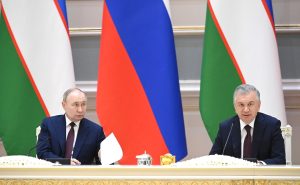Amid a state visit to Uzbekistan this week, Russian President Vladimir Putin and Uzbek President Shavkat Mirziyoyev shook hands on an agreement that could see construction of Central Asia’s first nuclear power plant – though at a smaller scale than earlier anticipated – start as soon as this summer.
Mirziyoyev heralded Putin’s visit, one of his first trips abroad (after China and Belarus) following his recent inauguration into an unprecedented fifth term as president, as “historical” and marking “a new age in the comprehensive strategic partnership and alliance relations between our countries,”
Mirziyoyev said an agreement was signed on the implementation of a “low-power nuclear power plant.” The Uzbek president commented, “Almost all leading countries in the world ensure their energy security and sustainable development through nuclear energy.” Mirziyoyev called the project “vital.”
He went on to note Uzbekistan’s large uranium reserves. While Uzbekistan’s reserves are considerably smaller than those of neighboring Kazakhstan, Tashkent remains a major producer.
During Putin’s state visit, Rosatom Director General Alexey Likhachev and UzAtom Director Azim Akhmedkhadzhaev agreed to expand cooperation. A contract was signed between Atomstroyexport, a Rosatom subsidiary that exports nuclear power equipment and services, and the UzAtom subsidiary responsible for the construction of Uzbekistan’s first nuclear power plants.
Six reactors, with a capacity of 55 MW each – 330 MW total – are slated to be built in Jizzakh region.
At the signing, Akhmedkhadzhaev pointed to soaring energy requirements in Uzbekistan, with demand expected to nearly double by 2050.
“All over the world, we are now seeing an increase in interest in the creation of new nuclear capacities, both in terms of the construction of high-power nuclear power plants and in the projects of small modular reactors,” he said.
The new agreement arguably builds off a nearly seven-year nuclear cooperation journey between the two countries.
In late December 2017, the two sides signed a nuclear cooperation agreement. The early discussions focused on two VVER-1200 pressurized water reactors, with a 2.5 GW capacity. In the next year, Uzbekistan shortlisted 10 sites for possible nuclear power plants, many of them in Jizzakh region.
In the summer of 2019, Uzbek officials mentioned ambitions to build four nuclear power units. In October 2019, Likhachev suggested in interviews that contracts for construction would be signed by year’s end – that didn’t happen. For the next few years the project seemed to stall, or at least discussions in public went dormant.
But in December 2022, amid a visit to Uzbekistan, Russian Prime Minister Mikhail Mishustin resurrected conversation about he project, saying it was “necessary to speed up the implementation of the agreements reached” on the nuclear power plant effort.
At the time, I noted the challenges facing the project, most notably financial questions and geopolitical concerns, and factors influencing Russia’s desire to put it back on track.
And back on track it seems to be, albeit at a more limited scale.
Reporting on the most recent agreement, as mentioned above, cited plans for six small nuclear reactors. According to the International Atomic Energy Agency (IAEA) small modular reactors (SMRs) are “advanced nuclear reactors that have a power capacity of up to 300 MW(e) per unit, which is about one-third of the generating capacity of traditional nuclear power reactors.” The IAEA noted in a September 2023 explainer: “Both public and private institutions are actively participating in efforts to bring SMR technology to fruition within this decade.”
Rosatom’s Likhachev this week boasted that the agreement with Uzbekistan was the “first-ever export contract for the construction of a small nuclear power plant.”
“This is not just a preliminary agreement; we are starting construction this summer,” he said.
Likhachev also said in an interview that plans for large nuclear power plants in Uzbekistan are still on the agenda, though specifics have not been offered.
Russia and Uzbekistan set up a joint fund of $500 million to finance projects in Uzbekistan, with $400 million coming from the Russian side. Putin explained the funding decision thusly: “This is not because we have more money, but because we have great interests in this part of Asia and we see that they can be realized taking into account the stability of the political system and the conditions for investing in the economy of Uzbekistan.”
Uzbekistan has already begun to feel the pressure of its own rising energy demands, with notable gas shortages and electricity outages in recent years. The pressure is most acute on the country’s gas industry, with existing lucrative contracts to export to countries like China and Afghanistan clashing with domestic demands. In the short term, this has motivated Uzbekistan to engage in an unofficial “trilateral gas union” whereby Russian gas is imported into Uzbekistan via Kazakhstan.
Adding nuclear power – even if just a little bit – as soon as possible may help alleviate the pressure, too.

































